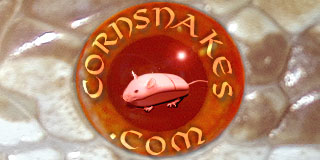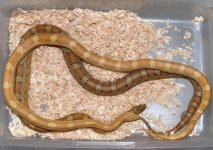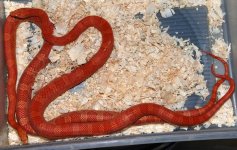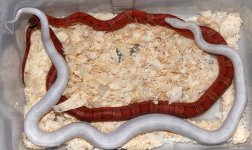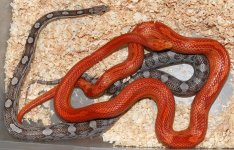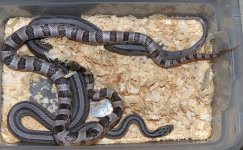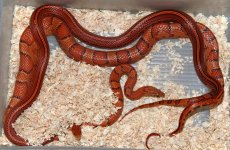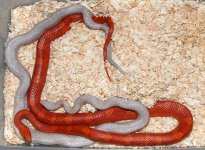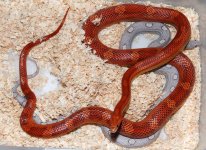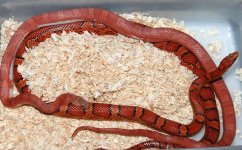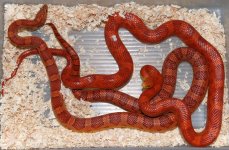Sometimes when people get results like that, it makes me wonder if any of the corn snake mutations are "linked," a term describing two loci that are close together on the same chromosome. When this is the case, the alleles at those two loci are no longer inherited independently of each other, which has implications when you are trying to make a double homozygous animal.
For example, say you crossed a lava (vvCC) and a charcoal (VVcc) to make het lava het charcoals (VvCc). If the lava and charcoal loci are on the same chromosome, in the het offspring one member of the chromosome pair has the V and c alleles (inherited from the charcoal parent), and the other chromosome has the v and C alleles (inherited from the lava parent). Normally, you would expect these hets to be able to make Vc, VC, vC, and vc sperm/eggs, but linkage would prevent this, because the v allele is stuck on the chromosome with the C allele, and the V allele is stuck on the chromosome with the c allele, so when the members of the chromosome pair separate and go their separate ways into the gametes, v and C (or V and c) get dragged together into the same egg/sperm. So only two types of egg/sperm are produced, vC and Vc, making it impossible to produce diamonds, as no gamete carries both lava and charcoal mutations simultaneously.
The reason it wouldn't be impossible in reality is this: During egg/sperm formation, members of a chromosome pair line up and exchange segments of genetic material with each other, mixing up the allelic arrangements on those chromosomes in a process called crossing over. If an exchange happens between the lava and charcoal loci in the het lava charcoal animals described above, you would be able to produce VC and vc gametes (these gametes are called recombinant because their allelic arrangement is different from the original arrangement of Vc or vC in the parental chromosomes). However, the closer two loci are on the same chromosome, the less likely it is that a crossover event happens between them. If they are really far apart, a crossover happens at the maximum rate of 50%, generating results that are indistinguishable from independent assortment. If they are really close together, recombination is very infrequent. Whether lava and charcoal are linked is just speculation but accurate and detailed clutch data could disprove it.
If the linkage were very tight you would expect this result:
If you breed a charcoal to a lava to produce double hets, and cross these double hets to each other, you would get 1/4 lavas NOT het charcoal (inherited a vC chromosome from both parents), 1/4 charcoals NOT het lava (inherited a Vc chromosome from both parents), and 1/2 het diamonds (received a Vc from one parent and a vC from the other). Some types of normals (VVCC, VvCC, VVCc) and diamonds (vvcc) would be rare, as would charcoals het lava (Vvcc) and lavas het charcoal (vvCc), because those would require the inheritance of one or two recombinant chromosomes (vc or VC). Is this anyone's experience?
To see how I got that result, when genes are tightly linked you can kind of treat them as the same locus on a Punnett square. The gametes produced by the double het animals would be either mutant for lava and wt for charcoal, or wt for lava and mutant for charcoal. So either Vc or vC. Here is the square, treating the charcoal and lava loci as a unit:
____Vc__vC
Vc| VVcc VvCc
vC| VvCc vvCC
So only 3 genotypic/phenotypic classes.
VVcc=charcoal, not het lava
vvCC=lava, not het charcoal
VvCc=normal, het lava het charcoal.
This assumes perfect linkage, so even if the loci are linked, deviations from this result are normal. But this result is very different from what you would expect from independent assortment (the way we normally calculate the result of crosses involving more than one locus). Offspring deviating from the above square had to have inherited a recombinant chromosome, allowing us to calculate the "recombination frequency" between lava and charcoal. In a normal cross that involves 2 loci assumed to be on different chromosomes, the recombination frequency is 50% (you can prove this by comparing the results from a normal Punnett square to the one above), so frequencies between 0 (loci are really close together) and 50% (loci are really far apart or on different chromosomes) are suggestive of linkage.
There is a somewhat hilarious implication of this. If lava and charcoal were actually linked, if you did hit a diamond in the above cross, you might be tempted to mate it with its charcoal or lava littermates to produce more diamonds. But the Punnett square above should caution you against that! You'd have much better luck crossing the diamond to its normal siblings or one of the parents, although producing more diamonds would still rely on recombination happening in the gametes of the normals het lava charcoal.
However, all offspring of your diamond will automatically inherit a chromosome with the vc arrangement (since the diamond has two vc chromosomes, which is why it's vvcc). Thus, those offspring can easily produce vc gametes without recombination, allowing you to easily produce more diamonds when you mate a diamond to its offspring. If your pairing was diamond x homozygous wt, the offspring will be VvCc, but one of their chromosomes will be vc and the other will be VC. Thus, assuming tight linkage, roughly half their gametes will carry the vc chromosomes and half will cary VC. So your odds of getting more diamonds when you cross the diamond to its het diamond offspring should be closer to 1/2 than to the 1/4 you would normally predict!
Sorry for the long post, sometimes a simple concept leads you down several roads.
